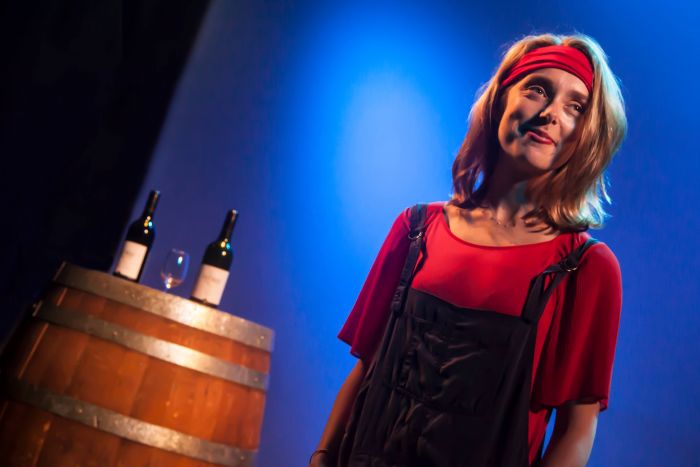A blindfolded Sophie (Keays) is introduced to us straightaway as trying to get a handle on life as she blunders around the periphery of an almost empty space. Eventually brought into contact with a barrel and wine bottle, she quaffs her red, confiding in us that putting on a blindfold opens up new vistas. However, the horizons in her daily life appear very limited and limiting. She, we learn, is selling wine by phone for CellarTasters and the conviction with which she portrays the pre-phone psyching-up suggests that she has had real-life experience of the job.
Sophie’s co-worker, Kirsty, is her opposite number. While Sophie is a would-be free spirit, Kirsty tries to exert control over her world, right down to lining up her pencils and checking off her list of “to-be-dones”. The cruise taken by this unlikely pair produces some of the play’s funniest observations. As the pleasure-loving Sophie watches the disciplined Kirsty doing laps in the ship’s pool, she reflects “In the rain. In a pool. In a boat. In an ocean.” Again, reflecting on the lack of meaningful activity, she compares a cruise to “being held hostage in a leagues club”. “Believe me,” she adds, “there were people on the Titanic praying for an iceberg.”
Then she meets the handsome Peter at an on-board wine-tasting whom she has “no intention of enjoying in moderation”. However, their relationship, to employ Sophie’s wine guide language “has legs” and they seem to be moving towards the middleclass dream. In response to a sad event, Sophie loses her ebullience, and their relationship breaks up as Peter dislikes the “new me” she becomes. An extension of the many wine metaphors used throughout, Sophie matures as she lives more in the “cool, secret places” where her memories are “laid down”.
Sophie’s blithe and often whimsical stream of thought, swirling from idea to idea, lingering longer on some sensations, sliding away and returning again, allows us to taste, dip into a range of subjects from bible stories to the nature of language. The flow is held together by the charisma of Keays, at her best perhaps when in the “cool, secret places”, but then again, her eyes really do sparkle when she makes a sly comment or caustic remark.
Barefoot, and dressed simply in a red blouse and blue short overalls, by turns jaunty, cajoling, teasing, she seems a brave but fragile figure. Life, like the wine we are served during the play, has to be tasted before value can be discovered, and it can be a bit rough.





